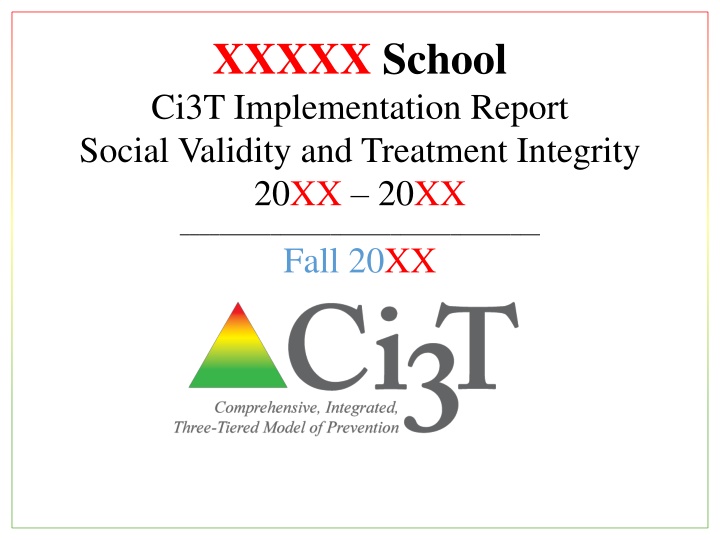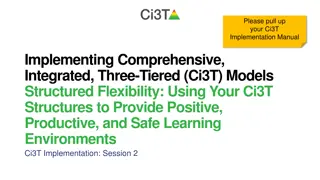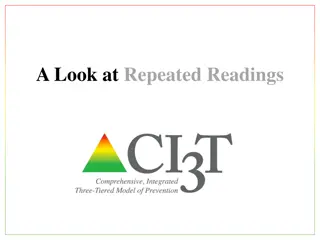
School Ci3T Implementation Report: Social Validity and Treatment Integrity
Explore the implementation of School Ci3T plan focusing on Social Validity and Treatment Integrity. Learn about the Primary Intervention Rating Scale (PIRS) and Treatment Integrity (TI) to assess the effectiveness of the plan.
Download Presentation

Please find below an Image/Link to download the presentation.
The content on the website is provided AS IS for your information and personal use only. It may not be sold, licensed, or shared on other websites without obtaining consent from the author. If you encounter any issues during the download, it is possible that the publisher has removed the file from their server.
You are allowed to download the files provided on this website for personal or commercial use, subject to the condition that they are used lawfully. All files are the property of their respective owners.
The content on the website is provided AS IS for your information and personal use only. It may not be sold, licensed, or shared on other websites without obtaining consent from the author.
E N D
Presentation Transcript
XXXXX School Ci3T Implementation Report Social Validity and Treatment Integrity 20XX 20XX ____________________________________ Fall 20XX
Essential Components of Primary Prevention Efforts Social Validity Treatment Integrity Systematic Screening Academic Behavior
Social Validity: Primary Intervention Rating Scale (PIRS) Educator Survey (Lane, Robertson, & Wehby 2002) The purpose of this survey was to obtain information that will aid in determining the effectiveness and usefulness of the Ci3T plan. Educators read each statement regarding the primary plan and select the number that best describes their agreement with each statement. Fall data indicate teachers expectations and initial perceptions of the primary plan. Spring data indicate the degree to which expectations were met and perceptions at the end of a year of implementation. Comments are used by the Ci3T leadership team to revise specific elements of the plan over the summer for the next school year.
Social Validity: Primary Intervention Rating Scale All faculty and staff received an emailed link to Qualtrics for the TSR and PIRS surveys
Social Validity: PIRS Results Year of Fall Spring Implementation n % (SD) n % (SD) 20XX-20XX Social validity refers to the level of: Social significance of intervention goals Social acceptability of intervention procedures Social importance of intervention outcomes (Wolf, 1978)
Treatment Integrity (TI) The degree to which the plan is implemented as designed Treatment integrity provides information on the elements of the plan that are being implemented Treatment integrity is needed to accurately interpret the effectiveness of the school s Ci3T plan
Measuring Treatment Integrity We used three measures of treatment integrity: 1) Ci3T Treatment Integrity: Teacher Self-Report (Ci3T TI: TSR) For all components of the Ci3T plan (Lane et al., 2009) 2) Ci3T Treatment Integrity: Direct Observation (Ci3T TI: DO) For two perspectives: observer and educator (30-minute snapshot; Lane et al., 2009) 3) School-wide Evaluation Tool (SET) version 2.0 For the PBIS component of the Ci3T plan (Todd et al., 2012)
Treatment Integrity: Teacher Self-Report All faculty and staff received an emailed link to Qualtrics for the TSR and PIRS surveys
Treatment Integrity: Direct Observation from Two Perspectives Conducted during the fall and spring treatment integrity window Educators observed were randomly selected from a stratified sample stratified across grade levels or instructional content (e.g., first grade, special education, English courses) Educators are defined as school personnel who directly instruct students Observers were trained to criterion on SET and direct observation protocols Educators were asked to rate the use of components based on the same 30-minute snapshot
Treatment Integrity: Teacher Self-Report and Direct Observation Results 20XX-20XX Treatment Integrity Procedures Teacher Self-Report Mean (SD) Direct Observation Fall 20XX Mean (SD) Direct Observation Spring 20XX Mean (SD) Fall 20XX n = Spring 20XX n = Educator n = Observer n = Educator n = Observer n = Teaching Reinforcing Monitoring - - - - Total Note. Monitoring procedures are not observed. A subset of observable teaching and reinforcement procedures are identified for observation. (-) = not applicable.
Treatment Integrity: School-wide Evaluation Tool (SET; Sugai, Lewis-Palmer, Todd & Horner, 2012) The School-wide Evaluation Tool (SET) consists of 7 subscales, each addressing a different component of school-wide positive behavioral interventions and supports as well as an overall summary score
Treatment Integrity: SET Results XXXXX School Total Points Possible Category Total Points Earned % Earned Fall 20XX Spring 20XX Fall 20XX Spring 20XX 4 Expectations Defined Behavioral Expectations Taught 10 On-going System for Rewarding Behavioral Expectations 6 System for Responding to Behavioral Violations 8 Monitoring & Decision- Making 8 16 Management 4 District-Level Support Goal: 80% on Behavioral Expectations Taught and Overall Scores TOTAL SCORE
Treatment Integrity: SET Results Percentage of Points Earned 0 20 40 60 80 100 Expectations Defined Behavioral Expectations Taught On-going System for Rewarding Behavioral Expectations Fall 20XX System for Responding to Behavioral Violations Spring 20XX Monitoring & Decision-Making Management District-Level Support Total Score
Implementing Ci3T Models of Prevention Your school s Ci3T liaison or coach is: NAME EMAIL For more information: www.ci3t.org





